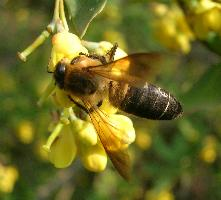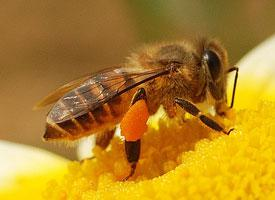
Description de l'animal
The Himalayan giant honey bee, scientifically known as Apis laboriosa, is a remarkable species of bee native to the high altitudes of the Himalayas, spanning countries like Nepal, Bhutan, India, and Tibet. This species is renowned for its substantial size, making it the largest of the honey bee species. The adult workers can reach up to 3 centimeters in length, a size that distinguishes them easily from their more commonly known relatives.Apis laboriosa leads a highly specialized life adapted to the harsh conditions of the Himalayan regions, which can range from 2,500 to 4,000 meters above sea level. The bees build their impressive, large, single-comb nests on the overhanging cliffs of these high-altitude forests. These nests, which are exposed to the elements and can measure more than a meter across, are not only a testament to the bees' architectural prowess but also serve as a defense mechanism against predators.
The lifecycle and behavior of the Himalayan giant honey bee are intricately tied to the seasons. With the onset of winter, entire colonies migrate to lower altitudes to escape the cold, returning to higher elevations as temperatures rise. This migratory pattern is synchronized with the blooming cycles of specific high-altitude plants, ensuring a consistent food source for these bees.
One of the most fascinating aspects of Apis laboriosa is their production of a unique type of honey, often referred to as "mad honey." This honey, rich in grayanotoxins from the nectar of the rhododendron flowers these bees predominantly forage on, has psychoactive properties. Local communities have used this honey for centuries for its medicinal benefits, which range from treating hypertension to various traditional uses in local ceremonies. However, in large quantities, it can be toxic, a fact well known to the locals who harvest it using traditional, sustainable methods that have been passed down through generations.
The practice of harvesting the honey from Apis laboriosa nests is a dangerous and skilled task, carried out by honey hunters who scale the cliffs to access the nests. This tradition is deeply ingrained in the culture of the local communities, and the honey harvested is highly valued both locally and internationally.
Despite its fascinating ecology and cultural significance, the Himalayan giant honey bee faces threats from habitat loss, climate change, and overharvesting of its honey. These factors not only endanger the species but also the traditional practices and livelihoods of the communities that depend on them. Conservation efforts are critical to ensure the survival of Apis laboriosa, requiring a delicate balance between traditional practices and sustainable management to protect these unique giants of the bee world.
Animaux similaires
Nouvelles photos d'animaux
Top 10 des animaux
- Dolphin gull (Leucophaeus scoresbii)
- Diana monkey (Cercopithecus diana)
- Moustached guenon (Cercopithecus cephus)
- Galápagos tortoise (Geochelone nigra complex)
- Japanese macaque (Macaca fuscata)
- Stone loach (Barbatula barbatula)
- Russian tortoise (Testudo horsfieldii)
- Greek tortoise (Testudo graeca)
- Common flying dragon (Draco volans)
- Vendace (Coregonus albula)


